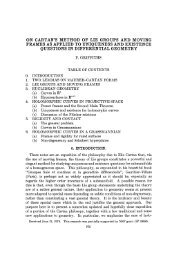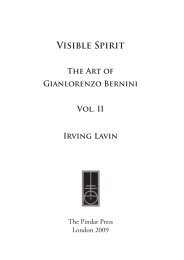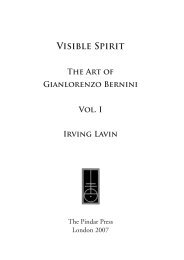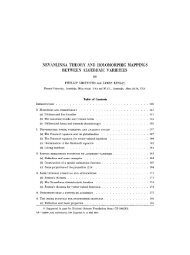?Pietro da Cortona?The Barberini Ceiling; Gianlorenzo ... - People
?Pietro da Cortona?The Barberini Ceiling; Gianlorenzo ... - People
?Pietro da Cortona?The Barberini Ceiling; Gianlorenzo ... - People
You also want an ePaper? Increase the reach of your titles
YUMPU automatically turns print PDFs into web optimized ePapers that Google loves.
“<strong>Pietro</strong> <strong>da</strong> <strong>Cortona</strong>—<strong>The</strong> <strong>Barberini</strong> <strong>Ceiling</strong>; <strong>Gianlorenzo</strong> Bernini—<strong>The</strong> Chapel of St.<br />
Teresa,” Art of the Western World, PBS Channel 13, October 30, 1989, in Episode 5,<br />
Realms of Light: <strong>The</strong> Baroque<br />
(http://www.amazon.com/Realms-of-Light-<strong>The</strong>-Baroque/dp/B007NEZIUI)<br />
(click here for first page)
“<strong>Pietro</strong> <strong>da</strong> <strong>Cortona</strong>—<strong>The</strong> <strong>Barberini</strong> <strong>Ceiling</strong>; <strong>Gianlorenzo</strong> Bernini—<strong>The</strong> Chapel of St.<br />
Teresa,” Art of the Western World, PBS Channel 13, October 30, 1989, in Episode 5,<br />
Realms of Light: <strong>The</strong> Baroque<br />
(http://www.amazon.com/Realms-of-Light-<strong>The</strong>-Baroque/dp/B007NEZIUI)<br />
Art of the Western World<br />
PBS Channel 13 October 30, 1989<br />
<strong>Pietro</strong> <strong>da</strong> <strong>Cortona</strong><strong>The</strong> <strong>Barberini</strong> <strong>Ceiling</strong><br />
In many ways the age of the Baroque was the <strong>da</strong>wn of a new era and people were<br />
acutely aware that somehow the human spirit had received a great infusion of power. One<br />
work of art, perhaps more than any other in Italy, both displays the new spirit and at the<br />
same time celebrates its descent upon the world. This is the frescoed vault by the painter<br />
<strong>Pietro</strong> <strong>da</strong> <strong>Cortona</strong> in the main ceremonial hall of the <strong>Barberini</strong> palace, built in Rome<br />
during the second quarter of the seventeenth century for the family of the newly elected<br />
pope, Urban VIII, the man who perhaps more than any other embodied and promulgated<br />
the transformation (Fig. 1).<br />
We feel its bold aggressiveness at a glance: the space of the room fairly erupts<br />
with turbulent masses of exuberant, cloud-borne and free-floating figures who perform a<br />
breathtaking aerial drama against the background of a heavy architectural vault and open<br />
sky beyond. <strong>Cortona</strong> succeeded in making even Michelangelo's mighty Sistine ceiling<br />
seem thin and fragile—a delicate house of cards populated by a series of se<strong>da</strong>te and<br />
isolated individuals, each viewed and illuminated uniformly from the front and quite<br />
1
oblivious to the series of small narrative scenes that march along the ceiling in regular<br />
rhythms, without any strongly defined focus (Fig. 2).<br />
<strong>Cortona</strong> instead conceived the vault as one, coherent, centrally focused unit, with<br />
four large but subordinate narrative panels along the sides, framing a single opening to<br />
the sky. <strong>The</strong> narratives are not confined within their frames but spill out and become part<br />
of the decoration of the vault itself. <strong>The</strong> illumination is not uniform; <strong>Cortona</strong> fills the<br />
whole field of vision with billowing contrasts that are created by light streaming down<br />
from a single source in the distant heavens. <strong>The</strong> accompanying figures are no longer<br />
attached to the architecture but seem to have freed themselves and taken flight, all viewed<br />
from a single standpoint below and all participating in a single event taking place at the<br />
apex. <strong>The</strong> figures are not simply noble and muscular; they seem to be inflated by some<br />
superhuman principle of vitality that incorporated the urgent and heroic message of<br />
which they are the inspired agents.<br />
<strong>The</strong> message is also a kind of intensification and concentration of that of the<br />
Sistine <strong>Ceiling</strong>. Christianity regarded itself as the successor to the two great religions of<br />
antiquity: Ju<strong>da</strong>ism and paganism. <strong>The</strong> Sistine ceiling recites the sequence of events that<br />
led through the promise of the Old Testament up to the fulfillment in the New. <strong>The</strong><br />
<strong>Barberini</strong> ceiling expresses essentially the same idea with respect to pagan mythology,<br />
except in a more structured way and with a more precise aim. <strong>The</strong> episodes that decorate<br />
the sides of the vault—such as Hercules dispatching the Harpies, and Minerva defeating<br />
the Giants—are not told sequentially but are selected and arranged, like the design of the<br />
vault, in a coherent system of values. <strong>The</strong> moral significance of these events from the<br />
pagan past for the Christian present is embodied in the airborne personifications of<br />
2
Justice, Wisdom, Peace, and so on, who occupy the real space of the room, and testify<br />
that those ancient presagements have indeed been subsumed beneath the infinitely greater<br />
power of the Christian virtues that now inhabit the world.<br />
<strong>The</strong> new regime of beneficence was inaugurated the <strong>da</strong>y Urban VIII was elected<br />
pope, the event celebrated in the open center of the vault where the crucial interchange<br />
between the earthly and heavenly realms takes place. <strong>The</strong>re the grandiose figure of<br />
Divine Providence, the heroine of the drama, sits on a throne of clouds, her head radiating<br />
light; she points toward a chorus of floating maidens who carry aloft an emblem of the<br />
pope's coat of arms: a flight of three enormous beesthe famous <strong>Barberini</strong> beesplus<br />
the crossed keys to heaven that Christ had given to St. Peter, the first pope, and the papal<br />
tiara poised for the coronation of Peter's latest successor (Fig. 3). <strong>The</strong> miracle-working<br />
bee, which transforms nectar into honey, was a traditional symbol of Divine Providence.<br />
But what motivates the whole conception of the vault, giving it a kind of inner vibrancy<br />
of meaning analogous to the dynamism of the fresco itself, is the allusion to a wondrous<br />
thing that happened during the conclave of cardinals at which Urban was elected. A real<br />
swarm of bees actually flew into the Sistine Chapel, where papal conclaves are always<br />
held. Of course, the outcome of every papal election, no matter how fraught with<br />
controversy and political maneuvering, is the expression of God's will. But the descent of<br />
a flight of bees at the election of a man whose own personal emblem was studded with a<br />
trinity of bees, must have seemed truly heaven senta resounding herald of the new era<br />
of spiritual and material well-being in which, under Urban VIII, peace, prosperity and the<br />
virtues of Christianity would reign supreme.<br />
3
<strong>Gianlorenzo</strong> BerniniChapel of St. Teresa<br />
It is your good luck to see Maffeo <strong>Barberini</strong> pope, but we are even luckier in that<br />
the Cavaliere Bernini lives at the time of our pontificate. He is a rare man and a sublime<br />
artist born by divine disposition, and for the glory of Rome.<br />
<strong>The</strong>se statements by the great pope about his favorite artist are significant in two<br />
ways. <strong>The</strong>y were prophetic of the prodigious role Bernini would play in his works for<br />
Urban and the succeeding popes for a period of 60 years; Rome was transformed into a<br />
modern city, replete with public monuments meant not just for the elite but for everyone<br />
to admire and enjoy. <strong>The</strong> open arms of the vast porticoes in front of St. Peter's convey<br />
exactly this sense of outreach beyond the traditional bonds of society to include every<br />
individual in a universal embrace.<br />
Urban's words also reflect the awareness, expressed in the <strong>Barberini</strong> ceiling, that<br />
there was something extraordinarily, even supernaturally propitious about the period and<br />
the people born to give it form. This dual concern for incorporating the individual into a<br />
comprehensive world order of divine perfection is made visible in what Bernini rather<br />
archly described as his "least bad" work: the Cornaro family chapel, dedicated to the<br />
sixteenth-century Spanish mystic St. Teresa of Avila, which Bernini created about 1650<br />
in the church of Santa Maria della Vittoria in Rome (Figs. 4, 5). Here Bernini gave<br />
entirely new expression to the Church's offer of succor in man's deepest and <strong>da</strong>rkest<br />
moment of need. He used the mortuary chapel to define the inner relationship between<br />
the death of ordinary mortals who yearn for help, the death of sainted mortals who may<br />
4
intermediate on our behalf, and the death of Christ through which the salvation of all<br />
mankind was assured.<br />
<strong>The</strong> process begins at the entrance to the church, when our eyes are met by those<br />
of the cardinal patron who looks out from among his ancestors and accompanies the<br />
visitor down the nave to view the chapel from the center of the crossing. <strong>The</strong>re we are<br />
confronted, in the relatively modest and confined space of the chapel, with a spectacle of<br />
truly cosmic proportions. In the pavement before the altar gesticulating skeletons rise<br />
from the lower depths to face their maker at the end of time (Fig. 6). At the sides the<br />
members of the Cornaro family appear in balconies with architectural backgrounds<br />
whose perspectives merge with that of the churchfrom this vantage point their space<br />
becomes indistinguishable from ours (Fig. 7). Separately and together they consider,<br />
study, discuss, describe, indicate, and thereby bear witness to a mysterious event in which<br />
they participate, encouraging us to join them.<br />
<strong>The</strong> vault of the chapel has scenes from St. Teresa's life in real, not feigned stucco<br />
relief; unlike <strong>Cortona</strong>'s <strong>Barberini</strong> vault there is no opening here. By superimposing a<br />
layer of painted molded plaster over the raised relief, Bernini makes a chorus of winged<br />
and cloud-borne angels, singing, playing instruments and strewing flowers, seem to filter<br />
through the solid vault, filling the chapel with their fragrant hymns of praise and<br />
celebration.<br />
What the pavement, the side walls, and the ceiling all celebrate is the two-fold<br />
miracle event taking place at the altar, the Institution of the Eucharist at the Last Supper,<br />
represented on the front of the altar, and its counterpart in the Glorification of St. Teresa<br />
represented above. Here Bernini created a visual sensation by making a public spectacle<br />
5
of a literal portrayal of a woman in ecstasy. Teresa is shown reclining on a cloud, her<br />
limbs <strong>da</strong>ngling limp, her head thrown back, her mouth open in an anguished groan.<br />
Before her a curly headed cherub with an almost compassionate smile, delicately lifts the<br />
hem of her robe and thrusts the fiery <strong>da</strong>rt. Teresa's abdomen contracts in a paroxysm of<br />
receptivity. Her very drapery seems to crackle with the consuming ardor of the angelic<br />
touch that raises her heavenward.<br />
<strong>The</strong> overt sensual content of Bernini's altarpiece has been the subject of untold<br />
controversy. Teresa's visions have themselves been interpreted as hysterically induced<br />
eroticism, and Bernini was accused even in his own <strong>da</strong>y of reducing her experience to the<br />
level of vulgarity. Whether or not Teresa was hysterical or Bernini vulgar, the group<br />
evinces a physical eroticism it would be wrong to deny. From time immemorial,<br />
beginning with the Song of Songs of the Bible, mystics have used the vocabulary of<br />
earthly love to convey their feelings to otherscommunion with God is like communion<br />
with the lover, only infinitely more so.<br />
This is the path Bernini boldly followed in helping ordinary mortals to perceive,<br />
however faintly, a state of being of which our earthly experience is but a pale reflection.<br />
Indeed the pure white image, glowing softly in the shower of half-light, hovers before us<br />
like an apparition midway between nothingness and reality.<br />
Bernini's altarpiece fuses three episodes in Teresa's spiritual life that together<br />
embody the quintessential nature of her sainthood. One of these was the famous vision of<br />
the Transverberation, which she describes in her autobiography. "In the angel's hands I<br />
saw a long golden spear, and at the end of the iron tip I seemed to see a point of fire.<br />
With this he pierced my heart several times so that it penetrated my entrails. When he<br />
6
drew it out he left me completely afire with a great love for God." <strong>The</strong> second event was<br />
an occasion when, upon receiving communion at mass, she was seen to levitate, actually<br />
rising several feet above the ground on a cloud. <strong>The</strong> third was Teresa's death which, it<br />
was reported by those present, did not occur from natural causes; after receiving her last<br />
communion, the elderly and rather homely woman suddenly became young and radiantly<br />
beautiful, and expired in a transport of love, uttering terms of endearment to her heavenly<br />
spouse. In other words, Teresa was a martyr, not in the sense of dying for her faith but in<br />
the sense of dying of her faith. This mystical marriage to God is the key to Teresa's<br />
sainthood, the key to her role in salvation, and it is the key to the chapel's design. Never<br />
before had a volume of space been treated with such pervasive and encompassing unity;<br />
all the partsthe floors, the side reliefs, the vault and the altarpieceare not only related<br />
to one another, they interpenetrate, to the point where we can no longer distinguish the<br />
media from one another: is the floor a pavement to be walked on or a painting to be<br />
looked at? Are the side reliefs sculpture or architecture? Is the vault apparition painting<br />
or molded stucco? Is the altar tabernacle a little temple or a niche in the wall? Is the<br />
altarpiece illuminated by the light from the small window above or by the coagulated<br />
golden rays behind? Is the altarpiece a relief or free-standing sculpture?<br />
It is as though Bernini sought to give visual form to Teresa's union with God by<br />
the unity of his chapel design; to suggest the fusion of our nature with Teresa's and hers<br />
in turn with her spouse's, by the fusion of architecture, sculpture, and painting into one<br />
seminal substance of creation. Love, in the form of charity, is the prime Christian virtue,<br />
and love is the ultimate principle of creation. <strong>The</strong> prime tenet of Christianity is that God<br />
created the world out of his love for humanity. Imitating God, Bernini made love and<br />
7
creation the key to his chapel: he as much as said so when he placed at the apex of the<br />
entrance vault a pair of angels who carry Teresa's wedding (bri<strong>da</strong>l) wreath, and an<br />
inscription bearing the beautiful words Christ spoke to Teresa in another of her visions:<br />
"If I had not created heaven, I would create it for you alone."<br />
In a way, the Teresa chapel can be understood as a kind of sublime theater<br />
spectacle. <strong>The</strong> Baroque was indeed a great age of illusionism in the theater, and Bernini<br />
was himself renowned as a theatrical producer, playwright and inventor of wonderful<br />
stage effects. His tricks, however, were of a different order than those of his<br />
contemporaries. In one play, for example, an actor with a torch "accidentally" sets the<br />
scenery on fire, threatening to burn the theater down; in another, the bank of a river scene<br />
on stage suddenly gives way, threatening to submerge the audience in a flood. <strong>The</strong> secret<br />
of Bernini's success was that upon the illusion normally expected in the theater, he<br />
superimposed another illusion that was unexpected and in which the audience was<br />
directly involved. In an instant, each individual spectator became an actor, conscious of<br />
himself as a passionate participant in a universal happening. So it is in the Teresa chapel,<br />
where Bernini made of his own creation the image of all creation.<br />
8
LAVIN_AWW_ILLUSTRATIONS<br />
Fig. 1 <strong>Pietro</strong> <strong>da</strong> <strong>Cortona</strong>, vault, ceremonial hall. Palazzo <strong>Barberini</strong>, Rome.<br />
(click here to return to text)<br />
9
LAVIN_AWW_ILLUSTRATIONS<br />
Fig. 2 Michelangelo, Sistine ceiling. Sistine chapel, Rome.<br />
(click here to return to text)<br />
10
LAVIN_AWW_ILLUSTRATIONS<br />
Fig. 3 <strong>Pietro</strong> <strong>da</strong> <strong>Cortona</strong>, Divine Providence and the Coronation of Urban VIII. Palazzo <strong>Barberini</strong>, Rome.<br />
(click here to return to text)<br />
11
LAVIN_AWW_ILLUSTRATIONS<br />
Fig. 4 Bernini, Chapel of St. Teresa. Cornaro Chapel, S. Maria della Vittoria, Rome.<br />
(click here to return to text)<br />
12
LAVIN_AWW_ILLUSTRATIONS<br />
Fig. 5 Bernini, Ecstasy of St. Teresa. Cornaro Chapel, S. Maria della Vittoria, Rome.<br />
(click here to return to text)<br />
13
LAVIN_AWW_ILLUSTRATIONS<br />
Fig. 6 Bernini, Chapel of St. Teresa. Cornaro Chapel, floor, S. Maria della Vittoria, Rome.<br />
(click here to return to text)<br />
14
LAVIN_AWW_ILLUSTRATIONS<br />
Fig. 7 Bernini, Chapel of St. Teresa. Cornaro Chapel, side panels, S. Maria della Vittoria, Rome<br />
(click here to return to text)<br />
15
















